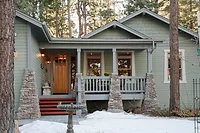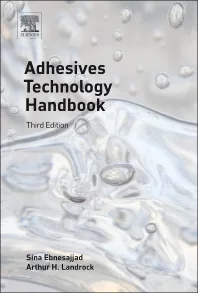Wonderware HMI Helps Dürr Behr Painting Systems Provide Common
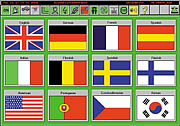
The company is part of the Dürr Group, a technology company employing 3,300 people around the world that creates integrated solutions not only for painting installations but also for industrial cleaning and environmental systems, and automation and materials-handling technology. Because they serve customers all over the world, Dürr Behr often used to run into problems both in commissioning and in aftersale servicing.
“Every manufacturer uses a different PLC, so control systems are not standardized anywhere in the world,” explained Jan-Peter Grigoleit, director of Software Development. “In the States, they use Allen-Bradley; in Germany it’s Siemens or AEG; in Scandinavia, especially Sweden, they have SATT Control; in England it’s GEC; in France, and Spain, Telemecanique; in the Far East, also Telemecanique, and now Mitsubishi and Modicon. Different people in different companies would develop different interfaces, running on different hardware, so it was hard even to repair the systems. And we lost a lot of time and money educating the various subcontractors we use to commission the systems.”
In 1992, the company decided to solve these problems by developing a standard user interface that would present a common “look and feel” to any PLC system. This flexible interface had to meet a number of criteria. First, it had to be hardware-independent and easily customized to customers’ widely divergent needs, yet it had to be an improvement on current systems. It had to be something that multinational customers such as Ford, General Motors, Volkswagen, DaimlerChrysler Benz, BMW or Fiat could use in all their plants worldwide. And it had to be something Dürr Behr could develop quickly, because the time between order and shipment of a system is often short.
After looking at a dozen different possibilities, Dürr Behr chose the Wonderware® InTouch™ human-machine interface (HMI) software from Wonderware Corp., Irvine, CA. InTouch provides Dürr Behr’s systems with a uniform, object-oriented graphical user interface that runs on personal computers (PCs) in a Windows environment, which is rapidly becoming an international standard operating system for factory applications.
Wonderware’s open architecture and extensibility provide Dürr Behr’s clients with supervisory control and data acquisition (SCADA) capabilities for whatever PLCs they might choose to implement. But hardware independence wasn’t the only benefit gained. As an added bonus, the HMI screens can be customized at the click of a mouse to allow users to easily switch between languages on screen.
“In some countries customers use two different languages. In Belgium, for example, they speak Flemish and French,” Grigoleit explained. “Union rules there require factories to have both languages online. But the ability to switch languages is also an important feature for our service people and for people at our multinational clients who travel to different sites around the world, because they can always call up screens in their own language.”
At Ford in Portugal, for example, the British staff members naturally all spoke English, but the operator interface had to be in Portuguese for the operators. Using the new Dürr Behr screens, users can simply press a button on the HMI screen and switch between English and Portuguese. And it was so quick to develop, Grigoleit recalled, that “within two weeks of starting to develop our first application using Wonderware InTouch, we were able to use it in a presentation for a job at Ford in Portugal.”
“This is a similar application we did for Chrysler in Mexico,” he added, demonstrating a screen. “I can click the mouse and the screen is in Spanish. Or in Portuguese. French. German. English. Just click on the flag button for the country and language you want.”
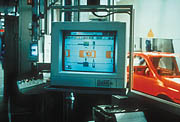
Painting With Bells On
Following the success of that initial presentation in Portugal, Dürr Behr started development of their standardized application for auto painting systems, which they call Ecopaint because its innovative technologies minimize emissions while maintaining the highest levels of paint quality.“Our clients are concerned not only with cost and quality, but also with meeting the requirements of stringent environmental laws and regulations,” Grigoleit said. “The new HMI makes possible the precision painting that is so important for both economic and environmental reasons. The more precisely paint can be delivered, avoiding areas that require different paint — or no paint at all, like the windshield — the less paint is needed. Furthermore, paint that goes directly onto the car does not go into the air or the plant ventilation system, ultimately preventing pollution of the atmosphere.”
In a typical Ecopaint installation, auto bodies are carried on a conveyor belt between painting “booths” and infrared or air driers. An Ecopaint booth is like a gallery, with different machines or “stations” for each step of the painting operation. Paint is applied in a three stage process: first primer is applied, followed by base coat, which carries the color, and then a clear topcoat. A drying period must be provided between each layer’s application.
Dürr Behr’s unique technology applies the paint using high-speed “bells,” or sprayers, which rotate at 30,000–50,000 revolutions per minute. As the paint sprays from the center of the bell at a controlled rate, the rotation atomizes it into a fine mist. Shaping air blown from small valves surrounding the bell then precisely controls the direction and width of the paint spray pattern. A bell-shaped cone (from which the sprayers get their name) further reduces overspray and dispersion.
Most paint machines have three bells for each side of the car and three for the top, for a total of nine bells for painting passenger cars. Large vehicles like trucks require four bells per station, for a total of 12. A typical booth might have one station for primer, one for basecoat and two others for clearcoat. Some installations also employ robotic sprayers for detailed or special paint jobs.
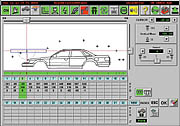
Parameter Tracking & Trending
With Wonderware InTouch, operators can monitor the entire painting operation from the PC screen, keeping track of the conveyor movement and speed; the status of the bells and shaping air; the movement of vehicles through the machines; the required and actual value of the high tension power flow rate and turbine pressure; the status of communications between the PC and the PLC; and any alarm conditions. Operators can almost literally “watch” the auto bodies progress through the paint chamber, in real time, as animated on the HMI screen. The program also provides on-screen displays showing the type of car, the body style and the color.“With other systems it was impossible to animate the screens so well,” Grigoleit said. “In the past, we had big windows through which the operators could look into the booth to see what was happening. Now, because the paint machines are installed in the walls of the booths, the operator no longer has the possibility of looking inside; he has to depend on his computer screen. With the animated HMI screen, he can watch where each car actually is in the process, in real time.”
The parameters for a specific car are loaded automatically upon entry of a model number, but the HMI provides operators with the ability to adapt the process easily to changing conditions. With an atomizer schematic, the operator can see and adjust the status of all the valves, as well as the main needle at the valve.
“When the temperature of the booth or the viscosity of the paint is changing a bit, the operators may have to change the flow rate of the paint onto the back door, or the front door, or the roof,” Grigoleit said. “But management maintains control over any of these changes. As operators change the paint or profile parameters, the data is logged in a parameter change log, which is date- and time-stamped with the operator’s name and ID number, making it easy to identify the person responsible for any change.”
Since Wonderware InTouch provides the ability to share all real-time data with any other DDE-aware program on the PC network, Dürr Behr has new possibilities for making use of historical data and trending — to track problems such as uneven paint wear, for example.
“Operators can check the variables in effect when a particular car was painted and study the results,” explained Grigoleit. “They never had that resource available to them in the past. It’s possible to do with other HMI systems, but it was always such a large amount of work before that nobody did it — not for one single customer or for one single factory. But we now have developed it as a standard feature of our Ecopaint systems.”
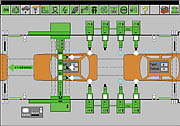
Just-In-Time Manufacturing
In an automobile painting operation, precise supervisory control is crucial, because most automobile plants manufacture cars just-in-time. That means that cars are painted to order based on a transaction request, rather than to inventory. “When a car comes into the paint shop, it’s a sold car, and the color is already specified,” Grigoleit explained. “As a result, each car coming down the line might be a different color. One car is white and the next car is green and the next car is red, and so on. There’s gap between the cars of only maybe a meter or two, and during that gap we have to purge and clean all the pipes and bells to prepare for the next color.” An error in those few moments between cars can be costly. But the HMI’s graphical interface and alarm capabilities help operators spot and fix problems quickly.Painting parameters change not only between cars, but on each car as well. Car bodies are divided into over a dozen zones, each to be painted separately. “We might have, for example, 11 atomizers, 10 different body styles, each divided into 16 zones, 30 different colors, and flow rate parameters and shaping air parameters for each,” Grigoleit said. “We have variable turbine speeds, main needle switching points, paint color and viscosity, high tension, and purge programs, all depending on all the other variables. We normally have between 300-500,000 parameters to deal with in a painting operation. Before, operators simply couldn’t manage all those parameters. There was no way to have an overview. Now, the HMI displays all the information graphically, in real-time, on an easily read, intuitive screen.”
In the past, for example, operators had to keep their eye on tables filled with numbers to be sure the painting rates were correct. Now, that information is presented as a bar graph. “Operators can see at a glance if the values are correct or not,” Grigoleit observed. “This graphical interface also prevents typos, which used to cause painting errors that wouldn’t be noticed until the end of the line. Now, if the painting rate is supposed to be 200 ml per minute, and the graph says 20, the operators can spot it immediately. They can then click over to another screen and see where the problem is on the car, too. That’s the whole point of the operator interface — to give them the information they need to optimize operations.”
Look Before You Leap
Dürr Behr is continually testing new technologies and improving the efficiency and environmental friendliness of their systems, while meeting the needs of each customer. But those customers need information about costs, quality, processes, logistics and environmental protection measures — even including the design of the manufacturing facility — before they can make an informed investment decision.“It’s a disaster if a car manufacturer builds a plant and it turns out not to meet their needs,” said Grigoleit. “They want to know if they’re making the right technological decision before they build the factory. With Wonderware InTouch, they can base that decision on real information gathered in on-screen simulations.”
The HMI lets planners run what-if scenarios and try out different designs in an animated graphical representation so clients can visualize the runtime environment and see all the variables while the application is still in the development phase.
Furthermore, InTouch applications can be developed quickly. Some of the Dürr Behr menus and screens are standard; the rest of the system is easily modified for each customer’s needs based on their booth design and car models.
“We often have only very short turnaround times from orders to commissioning so we needed a tool that can be developed very quickly using teams working in parallel,” said Grigoleit. “With other systems, only one person can work on the development at a time, so it has to be developed serially. When you only have three months to develop a system and you have a stack of specifications running to a thousand pages or more, you need to have two to five people working on the application at the same time. We now create all our systems using only nine developers working as a team.”
The need for easy configuration doesn’t end when the installation is built. Every year, most manufacturers’ models and colors change and all the parameters have to be reprogrammed. Operators used to have to type everything into tables, which was a tedious and error-prone task.
“Now, we have a toolbox that lets us copy data from one body style to another, reload, save, erase, etc., all at the click of the mouse,” Grigoleit explained. “Customers now can do all of this editing and simulation in InTouch, in the office rather than on the plant floor. They can check it all out before they install it on the lines, and they know it’ll work right away.”
For more information on user-interface software, contact Wonderware Corp., 100 Technology Drive, Irvine, CA 92618; phone 949/727.3200; visit www.wonderware.com.
Looking for a reprint of this article?
From high-res PDFs to custom plaques, order your copy today!




